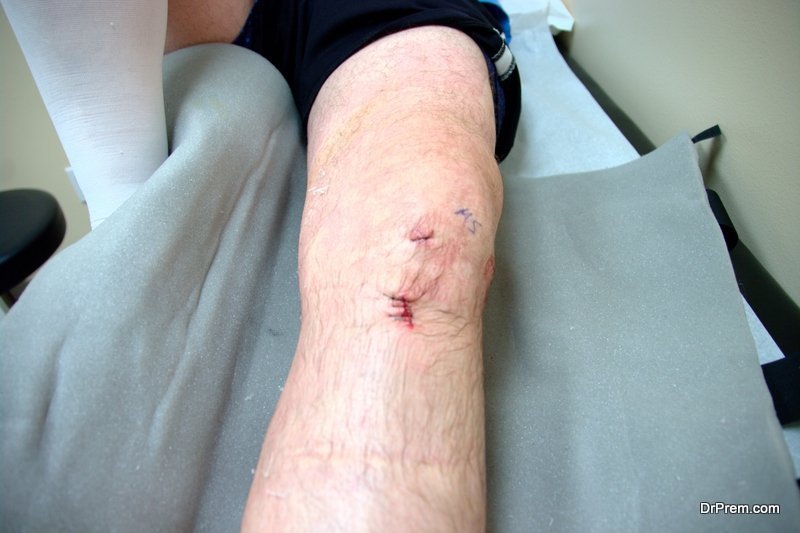High-impact sports and activities, falls, and age can all cause unwanted knee injuries. Not only is your knee the largest joint in your body but it’s also the most susceptible to injury. There are four main parts of the knee – bones, cartilage, tendons, and ligaments — and each are at risk for specific types of injuries. While knee injuries are common, most are easily treated using minor procedures, physical therapy, and preventative.
These tips can help if you think you’ve suffered a recent knee injury. Once the type of injury is determined, you and your doctor can decide on a treatment plan. Keep reading to learn more about the most common types of knee injuries and how they’re addressed.
1. ACL Injuries

Anterior Cruciate Ligament
ACL, or Anterior Cruciate Ligament, injuries are one of the most common type of knee injuries. They often affect professional athletes. You’ve likely heard of ACL tears or sprains. During high demand and high intensity sports like football, soccer, and basketball, athletes often change direction quickly and unexpectedly. This can cause tears in the ACL. Landing wrong from a jump (like in basketball), can also cause injury to this ligament. When the ACL tears, most people describe it as a “popping” sound. Ligaments in the knee are similar to rubber bands – when overstretched or pulled in the wrong direction, they can “snap”. Other symptoms include swelling, pain or discomfort in other areas of the knee, and difficulty putting weight on that leg.
Treatment
Treatment for an ACL tear varies depending on the severity of the tear. A complete tear in this ligament could require surgery. During this process, doctors completely reconstruct the torn ligament. Strains or mild tears in the ACL are often fixed with physical therapy and plenty of rest. You may need crutches if walking is difficult or a brace to help support and stabilize the injured knee. Physical therapy will help increase mobility and flexibility. The total recovery time for an ACL injury can range from 4 to 6 months.
2. Fractures
Just like any other bone or joint in your body, the knee is susceptible to fractures or breaks. Although knee fractures aren’t all that common, they do happen. And when they do, they can be incredibly painful. The knee is made up of several bones, which can all be fractured under certain conditions. The bone most often injured is the patella, which is located in front of the knee joint. This is the point where the femur (or thighbone) and the shinbone (tibia) meet.
The patella is responsible for protecting the knee. It also connects the muscles that run from the front of the thigh to your tibia. The patella is susceptible to injury because of its placement and function. It acts as a shield for your knee joint, and therefore, can experience a break of fracture while performing its job. A high force impact to the front of your knee can cause this type of injury. A patella break is very painful and makes it nearly impossible for the injured party to straighten their leg or walk.
Treatment
Fractures of the knee or patella bone specifically, don’t always require surgery. A brace may be enough to stabilize the knee and prevent movement while the bone heals itself. Depending on the severity of the break, you may need crutches to avoid placing unnecessary pressure on the injury, while some people can bear light weight on the leg while wearing a brace. As long as there are no pieces of bone displaced in your knee, surgery usually isn’t required. Recovery time for this type of knee injury is between 6 and 8 weeks. This is the amount of time it generally takes for a fracture or break to naturally mend itself.
3. Dislocation

Dislocation
Just like your shoulder, your knee has a bone with a joint and socket, which means it can be dislocated when moved the wrong way. There are certain levels of dislocation – complete or partial. Any time bone shift out of place, a dislocation has occurred. For people with healthy knees, a dislocation is often caused by a severe injury like a car accident, sports related injury, or fall. Clear signs that you’ve dislocated your knee are severe pain, the inability to walk, visible displacement of your knee cap and instability.
A knee dislocation can occur several different ways and is defined as the bones in your knee shifting out if place. Your knee cap can slip out of alignment but your tibia or femur can also be forced out of place, causing a dislocation. People with abnormalities in their knee structure are at higher risk for dislocation.
Treatment
A dislocated knee is treated like most other knee injuries and doesn’t require surgery. The main purpose of dislocation recovery is to stabilize the knee, giving it time to heal. This may involve the use of crutches or a brace. The RICE method is another commonly used treatment plan. RICE is an acronym for rest, ice, compression and elevate. Patients may also require pain medication while pain and discomfort persist. Anti-inflammatory medications will also help reduce swelling caused by a dislocated knee.
4. Ligament Injuries
The ACL isn’t the only ligament in the knee that is at risk of injury. The posterior cruciate ligament is located near the ACL and performs the same job — connecting the femur and tibia. This ligament is often injured during high-impact events like a car accident or other hard blow to the knee while the knee is bent. The knee also contains ligaments known as collateral ligaments.
These injuries usually occur when the knee is pushed sideways or in an unnatural position and are the least common of the ligament injuries. Treatment for these types of ligament tears and sprains is similar to that of ACL tears. Most often, rest and immobilization are enough for them to heal properly.
5. Tears

The knee is made up of several moving parts, which is why it’s so susceptible to injury. And ligaments aren’t the only part of the knee that suffers from injury or tears. Here are a few other examples.
Tendon
The tendons of the knee are similar to ligaments. Like rubber bands, tendons in the knee can be overstretched and eventually tear. Most tendon injuries occur during running activities. Older individuals are at higher risk for these types of knee injuries. People with weakened tendons are at highest risk for tears. The tendon near the patella bone, known as the patella tendon, is the one often associated with injury.
Symptoms of a tendon tear include a pulling or stretching feeling followed by pain, swelling, and the inability to fully mobilize the knee joint. You may also see an indent near the kneecap where the patellar tendon tore. Physical therapy, rest, and a brace are often enough to treat a tendon tear.
Meniscus

Meniscus
The meniscus is cartilage in the knee located between the femur and tibia as well. But unlike tendons or ligaments, the meniscus offers cushion for these bones and the surrounding muscle and tissue. Meniscal tears occur mostly during sports and other high impact activities that require sudden movement. Any type of pivitoring, twisting, or quick change in direction can cause a tear in the meniscus. Being tackled during contact sports is another common cause of this type of injury.
Arthritis and natural aging put you at greater risk for meniscus related injuries, as the cartilage weakens over time. A complete tear of the meniscus could require surgery, but most injuries will heal on their own with plenty of time, rest, and the RICE method mentioned above.
With so many moving parts, it’s no surprise that the knee is susceptible to a variety of injuries. Practicing safety and caution during sports and exercise can help protect your knee. Avoid sudden movements or change of direction whenever possible. While other knee related injuries are unavoidable (such as falls or motor vehicle accidents), most heal on their own without the need for surgery.
Article Submitted By Community Writer



